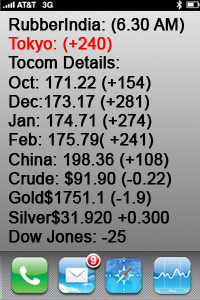May 30, 2025
Rubber India
Overview
Today, Japanese rubber futures experienced a decline, marking the first weekly loss in five weeks. This drop is attributed to increased supply from seasonal harvesting and ongoing uncertainty regarding U.S. tariffs.
Market Performance
Osaka Exchange (OSE): The rubber contract for November delivery fell by 7.1 yen (2.26%), settling at 307.5 yen ($2.14) per kg. The contract has decreased by 3.91% this week, its first weekly decline since April 25.
Shanghai Futures Exchange (SHFE): The September rubber contract decreased by 235 yuan (1.7%), reaching 13,605 yuan ($1,893.71) per metric ton. The active July butadiene rubber contract also saw a decline, dropping by 100 yuan (0.88%) to 11,245 yuan ($1,565.22) per ton.
Singapore Exchange (SICOM): The June delivery contract last traded at 162 U.S. cents per kg, down by 2.5%.
Supply Factors
As of May 28, domestic production areas and Vietnamese plantations have begun full-scale harvesting, which is increasing supply pressure in the market. The typical low production season lasts from February to May, followed by a peak harvesting period from June to September.
Trade Uncertainty
The market is facing trade uncertainty due to recent developments in U.S. tariffs. A federal appeals court has reinstated tariffs initially imposed by President Trump, reversing a previous court decision that had blocked these duties. This situation is contributing to volatility in the markets.
Currency Impact
In currency markets, the Japanese yen strengthened by 0.3% to 143.73 per dollar. A stronger yen makes yen-denominated assets less affordable for international buyers, potentially impacting demand.
Stock Market Reaction
The uncertainty surrounding U.S. tariffs also affected Japan’s stock market, with the Nikkei index falling by 1.4% to 37,880.58.
Conclusion
The natural rubber market is currently facing downward pressure due to increased supply and trade uncertainties. Traders should monitor developments in U.S. tariffs and the ongoing harvesting season for potential impacts on prices and market stability.



